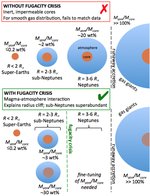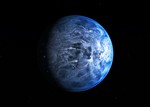Our research group helps lay the foundation for future missions to characterize potentially Earth-like planets and to search for signs of life.
Astrobiology & Future Missions

Publications
The Occurrence of Rocky Habitable Zone Planets Around Solar-Like Stars from Kepler Data
We present occurrence rates for rocky planets in the habitable zones (HZ) of main-sequence dwarf stars based on the Kepler DR25 planet …
Atmosphere Origins for Exoplanet Sub-Neptunes
Planets with 2 R_⊕ < R < 3 R_⊕ and orbital period <100 days are abundant; these sub-Neptune exoplanets are not well understood. For example, Kepler sub-Neptunes are likely to have deep magma oceans in contact with their atmospheres, but little is known about the effect of the magma on the atmosphere. Here we study this effect using a basic model, assuming that volatiles equilibrate with magma at T ∼ 3000 K. For our Fe-Mg-Si-O-H model system, we find that chemical reactions between the magma and the atmosphere and dissolution of volatiles into the magma are both important. Thus, magma matters. For H, most moles go into the magma, so the mass target for both H2 accretion and H2 loss models is weightier than is usually assumed. The known span of magma oxidation states can produce sub-Neptunes that have identical radius but with total volatile masses varying by 20-fold. Thus, planet radius is a proxy for atmospheric composition but not for total volatile content. This redox diversity degeneracy can be broken by measurements of atmosphere mean molecular weight. We emphasize H_2 supply by nebula gas, but also consider solid-derived H2O. We find that adding H_2O to Fe probably cannot make enough H_2 to explain sub-Neptune radii because >10^3 km thick outgassed atmospheres have high mean molecular weight. The …
Superabundance of Exoplanet Sub-Neptunes Explained by Fugacity Crisis
Transiting planets with radii 2-3 R_⊕ are much more numerous than larger planets. We propose that this drop-off is so abrupt because …
An Earth-Sized Planet in the Habitable Zone of a Cool Star
The diagram compares the planets of our inner solar system to Kepler-186, a five-planet star system about 500 light-years from Earth in …
Identifying the Rotation Rate and the Presence of Dynamic Weather on Extrasolar Earth-like Planets from Photometric Observations
Press Coverage Ocean Glints Could Reveal Alien Planets: Space.com, August 7, 2008 Twinkle, Twinkle, Alien Ocean: Astrobiology …
Characterization of extrasolar terrestrial planets from diurnal photometric variability
Press Coverage Earth from Afar: A Tiny Flickering Dot: Astrobiology News, February 27, 2002 Student sees way to get E.T.’s …




